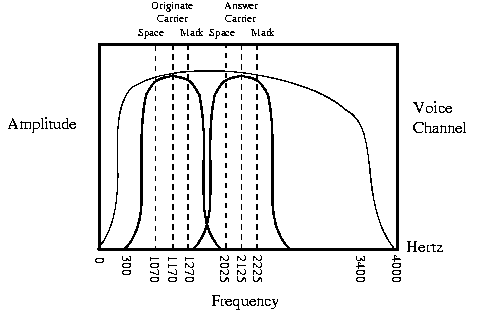| Introduction to Data Communications | ||
|---|---|---|
|
|
28a. FSK - Frequency Shift Keying (cont'd) | Next |
For Full Duplex, (data communication in both directions simultaneously) the upper bandwidth of the Voice Channel is utilized. Another carrier is added at 2125 Hz. A Mark or 1 is represented by 2225 Hz, and a Space or 0 is represented by 2025 Hz. The originating modem (the one which dials the phone number and starts the connection) uses the lower carrier (1170 Hz) and the answer modem (the one which answers the ringing phone line) uses the upper carrier (2125 Hz). This allocation of carriers is done automatically by the modem's hardware. The following diagram shows the Voice Channel with Full Duplex FSK.

Example of Originate's Frequency Modulated Carrier:

The originate modem transmits on the 1170 Hz carrier and receives on the 2125 Hz carrier. The answer modem receives on the 1170 Hz carrier and transmits on the 2125 Hz carrier. This way both modems can be transmitting and receiving simultaneously!

The FSK modem described above is used for 300 baud modems only. The logical question is "Why not use it for higher modems?". Higher data rates require more bandwidth: this would require that the Mark and Space frequencies for each band be moved farther apart (the originate and answer bands become wider). The two carriers would have to move farther apart from each other to prevent crosstalk (interference with each other). The limit for present phone lines is 1200 Baud Half Duplex (one way) used by Bell 202 compatible modems.
| Introduction to Data Communications | ||
|---|---|---|
|
|
Table of Contents | Next |